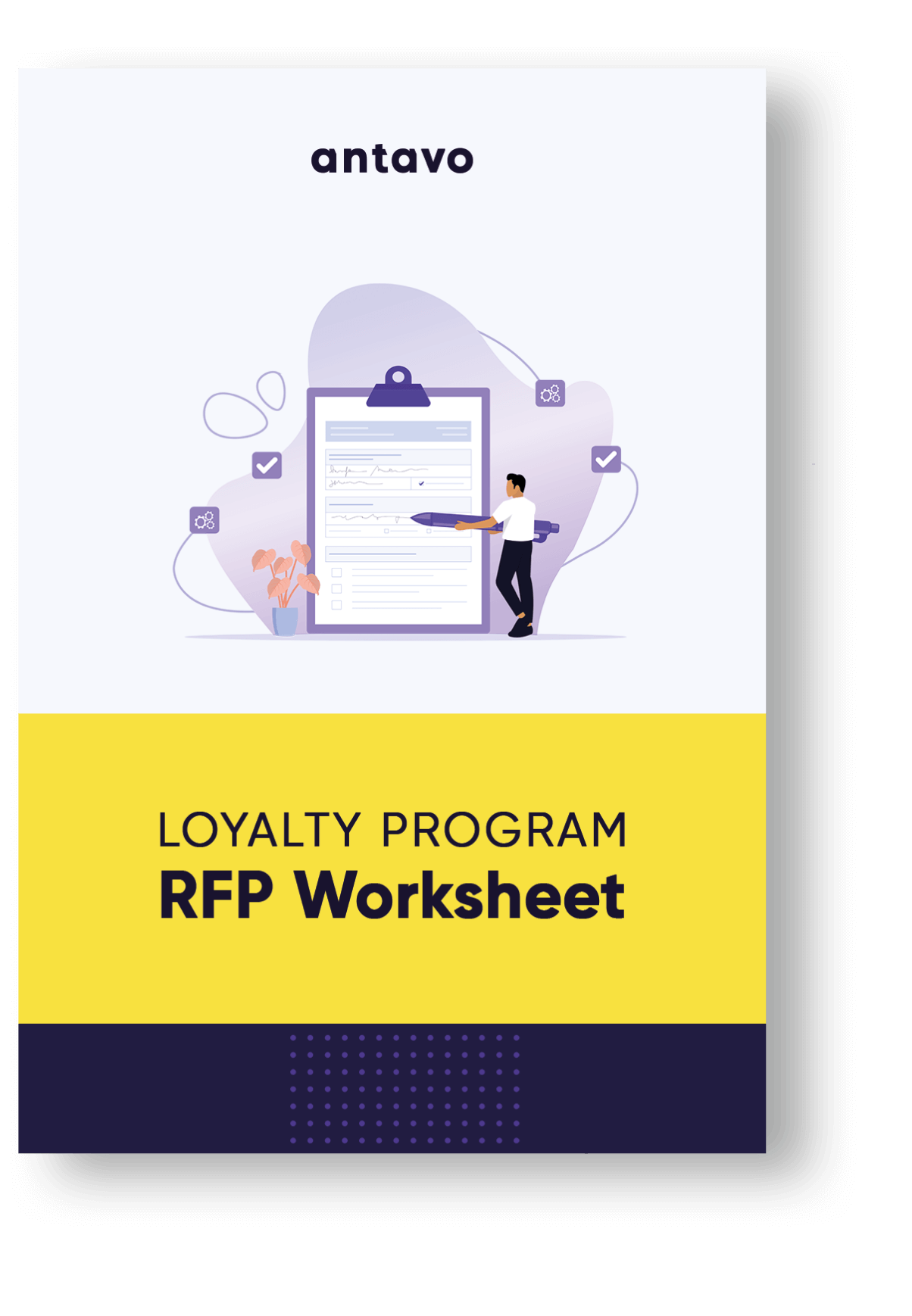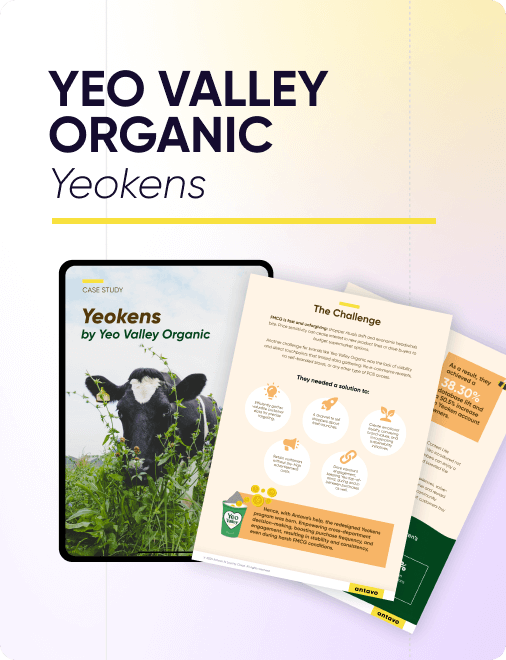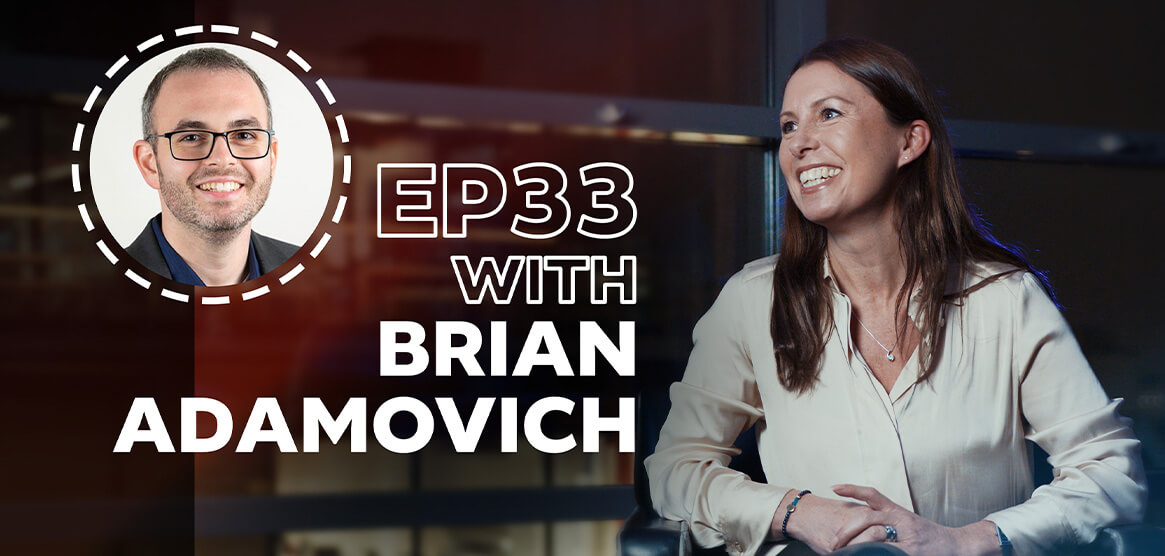Our guest for the 33rd episode of the Loyalty Stories podcast is Brian Adamovich, CEO at CultureKey.
The interview for this podcast has been a valuable source for Antavo’s Global Customer Loyalty Report 2024. Make sure to download it for over 30 statistics on loyalty program trends.
In this episode, we dive into the world of loyalty programs with Brian sharing insights on the growing trend of coalition loyalty programs, particularly how local businesses are banding together to create robust offerings. We also explore the impact of AI on the future of loyalty and highlight the key features brands should consider when implementing loyalty technology.
Highlights from our conversation with Brian:
- The importance of local coalition partnerships in loyalty
- How smaller businesses are excelling through emotional loyalty
- Significant changes in the loyalty industry in recent years
- His advice for rising loyalty managers
Learn more:
- LinkedIn profile of Brian Adamovich
- CultureKey website
- Read about creating coalition loyalty programs
- Book a demo with Antavo’s loyalty experts
Michelle
Hi, welcome to Antavo Loyalty Stories. I’m Michelle Ellicott-Taylor, Head of Global Partnerships at Antavo. We’re working with some key brands powering their loyalty campaigns with customers including KFC, and Benefit Cosmetics. In our loyalty series, we’re really excited to invite key experts in the field to come and talk to us about loyalty and talk about the customer trends that are going on right now and into the future.
So we’re delighted today to introduce Brian Adamovich, CEO at CultureKey, one of our key partners focused on the US market. Brian, thanks for joining us today. Would you like to give yourself, oh, not at all, would you like to give yourself a bit of an introduction?
Brian
Sure. It’s very nice to meet everybody today. My name is Brian Adamovich, as mentioned, I’m the CEO of CultureKey. We’re a professional services provider focusing on a full life cycle operational landscape. So we put our attention towards organizational adaptation and on demand leadership. We’re very non-transactional as an organization. So that means that we’re rooted in culture, empathy, integrity, and driving results.
And we don’t just do handing over a deck and running away. We actually stick around to do the work. So very exciting times for us at CultureKey. We just hit the market and the feedback has been incredible so far and we’re just, we’re so excited to be servicing our customers and their customers. As for me personally, I’ve been in professional services nearly my entire career.
I’ve touched on over 120 brands to date, including several in the loyalty space, which we’ll be discussing today. I’ve worked with really large Fortune 50 companies, all the way down to small organizations that are just getting started. In my loyalty career, I spent quite a few years at AMIA, which is formerly Carlson Marketing Group.
They were the early pioneers of loyalty in the US. They had the gold points program if that resonates with anybody who’s been around for a while. Since then, my career has taken a few interesting turns along the way. I’m recovering from a tourney. I had to kind of wash that away with an MBA, so I like to joke that I can read a P&L and a contract. Other than that, you know, I live in the US. I’m in Phoenix, so I love the hot weather and the desert.
I love exploring the restaurants, trying new things, and then kind of burning off those calories by hiking in the desert and in the mountains. I also coach youth basketball, and I enjoy that quite a bit. I’m again very happy to be here.
Michelle
Oh, that’s great. Thanks so much for the insight there. And you’ve got a wealth of knowledge by working with all the variety of clients that you’ve done. So hopefully we’ll get some more insights on that today. And I guess a good starting point for us really is thinking about what you’ve seen out there as far as loyalty is concerned. What do you think is a good example of someone that has done it like really differently, who’s really outstanding to you that gets you excited about what they’re doing with loyalty?
Brian
You know, I am a very big fan of shopping locally right now. That’s something that has really been at the forefront in the U.S. market. There’s been this concerted switch to more local shopping. So what’s really exciting to me is seeing the beginning seedling stages of coalition partnerships starting to take place in different markets, right?
When you have different mom and pops banding together to offer a concise and robust program that not only encourages you to shop with them, but also for you to go to their neighbor or to a complimentary lifestyle store. So I’m a big fan of that. As far as large programs go, I’m always a fan of REI. I think that they do a great job at rewarding customers and making them feel at home. But as far as the kind of the recent trends of coalition and partnership, I’m really loving what I’m seeing on that front.
Michelle
Excellent, okay. And then regarding the work that you do yourselves, what would you say is the work that you’re most proud of?
Brian
Yeah, absolutely, absolutely excited about bringing a lot of equity and inclusivity into the programs that we have been working on, making sure that all customers are accepted and we’re providing a deep breath of offerings for our end customers that excites them, brings them back and brings them into that.
Michelle
Excellent, okay. I guess some of the things you’ve alluded to already with what you’ve seen in the market, we’ve obviously been through a number of different years, but what would you say are really the main changes that you’ve seen in the loyalty industry over recent years?
Brian
Yeah, so we’re seeing a lot of eco-friendly and sustainable loyalty programs popping up. So environmental consciousness continues to grow. Loyalty programs may place a greater emphasis on sustainability. So that’s something that’s coming about. Gamification is, it’s been an ongoing conversation for over a decade now, but it’s better than ever.
AI powered services, and that’s everything from, you know, the offering, the core service down to AI powered chatbots and customer service. And, you know, just the way that the rewards engine works, I think that’s a very cool thing that we’re going to see a huge takeoff in the coming, you know, months and years to come. Obviously, with COVID, we’ve seen contactless and mobile wallet integrations become a huge thing.
Blockchain and crypto rewards are starting to become more and more popular, even though, you know, there’s a little bit of a lull right now. I think that the progress that was made since 2020, I don’t think that can be taken back. You know, there’s a lot of great innovation that’s happening. And again, going back to coalition, coalition programs, partnerships.
It’s really about, I love the focus on providing greater value to customers, winning them back, bringing them in, making them a part of an extension of the brand. I think that’s a very critical evolution in programs from the days of having a punch card. So I think we’re definitely headed in the right direction.
Michelle
Yeah, I mean, it’s interesting you say there about gamification, because it is, you know, some brands are talking about that as a new thing, like the immersive experience, but actually it’s been around a while, hasn’t it? It’s just that more brands need to move forward.
Brian
Yeah, I remember we were at AMIA in 2010 doing gamification and we felt like we were just catching up. So it is definitely, it still feels new. I think it’s definitely evolving with time and becoming a lot more interesting and bringing a different set of experiences to the customer. So I do think because it’s an established concept, I do think there’s a lot of room for continuous innovation and improvement.
Michelle
Oh, definitely. And I think that’s the kind of experience that so many brands, you know, want to use because people respond so well to that. So, yeah, that’s interesting. And I guess we’ve spoken about, I guess, some changes there. But do you see maybe some of the things you’ve touched on already, but like the two main trends in loyalty that you see that is coming, that people are going to be investing in the future?
Brian
So I do think that, yeah, I think AI, so AI is going to continue to evolve. You know, we’ve gotten a small taste of it this year. It’s becoming a household name. People are becoming more familiar with it. You know, chat GPT is the big buzzword right now, but there’s a lot more to it than that, right? So I think AI-powered loyalty is going to evolve. I think it’s going to create a lot more opportunities for rapid personalization, integration, it will be able to cater to very specific micro-targeting needs. So I love where we’re heading with AI.
And then again, going back to kind of more on the emotional side of things, I think emotional loyalty is going to be something that is going to be a focus in the future, right? So it’s about creating that differentiation, that value. So emotional loyalty is going beyond transactional rewards. Future loyalty programs may focus on building those emotional connections with customers. So brands can or should be building strategies that foster a sense of belonging, trust, shared values of this is what we believe in together and this is part of our brand creating those emotional connections beyond the transaction, I think, is really the next frontier of a successful loyalty program.
Michelle
Yeah, I think you’re right. Like there’s obviously the really good programs that brands have in place, like the point systems, the earn&burn, and they work really well with certain types of customer. But other brands are looking at where they can be more, they’re looking at this immersive experience on the gamification side, but creating that emotional loyalty side as well.
And that can tie in as well with something you said about ESG and sustainability and feeling good about the brand you’re associated with. So yeah, it’s gonna be interesting to see how these will evolve over the next couple of years. So I guess looking at some of the trends and things there, and obviously you’re talking with these customers and brands all the time about
I guess the loyalty story is what they should be in the strategy, what they should be building out. But when you’re thinking about the actual platforms that they need to be working with and how a loyalty tech vendor like Antavo can be supporting this, what are the main sort of features that I guess you’re thinking about as the consultant that’s going to make sure the brand can achieve what they want to?
Brian
Yeah, so I think it’s extremely important to follow the customer’s needs and balance their short-term requirements with the long-term vision, right? And one of the things that I believe that you offer really well is that ease of integration, right? That ability to, you know, when a client is ready to implement a loyalty program yesterday and they want it to work perfectly today with customizations. So I think it’s very important to be able to set them on the successful path quickly, to get those quick wins, to begin integrating quickly, for them not have to rebuild their tech staff, for them to be able to implement and then grow.
And I think that your platform, I think Antavo’s platform is uniquely positioned to create that sustainability and that growth and to grow with that from the MVP stage, right? All the way through a robust loyalty program, whatever that end state looks like is to be able to be that partner without having to constantly rewire and rebuild and restructure. Like having a platform that can seamlessly go along for that growth and be along for that ride as a strategic partner, not just a lever to pull, I think is critical.
Michelle
Yeah, and it’s interesting you say there about the growth as well, because looking at a loyalty program, it’s not, you know, putting something in for three months and expecting, there you go, there’s your ROI, it’s all working. It’s like it’s a long term investment. And I guess you must see there’s people who are planning for what they want to achieve in 12 months, 24 months, 36 months and so on.
Brian
It’s a long-term play and while you can always aim, what we always do is we set strategic KPIs for set periods of time, short, medium, long-term, with an eye towards the long-term not to sell out the future for the immediate. But with the loyalty program, you could get quick wins. It’s just important to not jeopardize what 36 months from now might look like to get the quick 90-day win.
Michelle
Yeah, exactly. And having something that you know is going to work in that short-term period while taking longer to think about, you know, that one further down the line. But yeah, that’s really interesting. And I guess kind of leads on to something else I was thinking about with regards to the actual Lordy consultants and people in these roles.
And we’re thinking about, you know, obviously there’s people coming in, you know, junior levels, let’s say, as a Loyalty Manager in their early stages of their career, early 20s and I guess what kind of advice would you be giving to people like that because you know they want to aspire to be the director of that loyalty and that consultant what are the I guess the considerations that they should be thinking about long term in a role like that?
Brian
Yeah, I think that’s an excellent question. I think getting to know the customer really well, really becoming, putting yourself in the shoes of a customer, becoming a customer advocate. It’s really becoming, putting yourself in a situation where you can represent what your customer’s desires, wants, needs, preferences are. So that when you are evolving the program as your responsibilities evolve, you are able to provide exactly what the customer is looking for.
Because if you don’t have that basis, if you don’t have that foundation, you can have the best tools in the world, your chances of missing the mark are pretty high. So it’s really important,
that anybody that’s building loyalty programs really gets into the heart and the mind of the customers and what their needs are.
Michelle
Yeah, and I think it’s also thinking about, I mean, that’s great. And thank you for sharing that. Because obviously lots of people are thinking, you know, in this whole space, that you said, loyalty has been such a, seen such growth and so many businesses now are looking at having this as part of their initial strategy, not something further down the line and therefore they’re employing people in these roles. But it doesn’t necessarily mean that all of these loyalty decisions sit just with that team.
And yeah, I’m interested to kind of understand more about who’s giving you the assignments. Like does the CEO get involved? Is it the head of digital procurement? But you know, who gets involved with these assignments?
Brian
Sometimes all of the above, right? It depends on the type of business and organization and the structure. Sometimes if it’s PE back, sometimes the PE will get involved because they have a vision and there’s possibly a vision for a coalition, partnership in the future. CEO, especially for a company that’s fairly new or growing ambitiously, the CEO loves to get involved.
We do work very closely with the CMO, the CTO, and the COO. And maybe a little bit surprising is that the CFO has a spot at the table too, right? Because there’s a financial implication involved. So it really is a team effort, especially depending on the type of customer.
If it’s a larger enterprise organization, it will be more of a director type level role that manages the relationships up to VP level. If it’s a smaller organization or an organization that’s rapidly growing, it’ll be in the VP or the C level of those respective disciplines. And it really is important to consider. It’s more than just one person, right?
A loyalty program impacts an entire organization and the entire organization structure. So, it’s important to remember that the CTO or whoever is in charge of technology will have an opinion on how, you know, this is implemented and how this is run. The CFO will absolutely, it will be a line item, hopefully an important integration into their considerations.
It really, when building the strategy, it’s important to consider, you know, who the stakeholders are and whether they’re an everyday contact or they’re a stakeholder in the background, you know, understanding what their needs are and anticipating how to service them is critical.
Michelle
Yeah, yeah, like that ties back in with what you said about the loyalty consultant needing to know the customer and know the content within that but also from an agency and consultancy side understanding who else is involved. So great.
Okay and then I was thinking about obviously you’re focused on North America as a key market for you and with regards to I guess regional differences with loyalty so do you see that within a region like that or is it more that you might say you see that Western Europe is different to how North America are reacting to loyalty programs or have you got some insights at all on regional differences?
Brian
Yeah, I think that, you know, so the United States is obviously, and North America is a very vast, geographically diverse market, which is very difficult to have a one size fits all approach. What you have in, what you cater to, you know, somebody even in California will be very different to my home state of Arizona, very different markets. And then even within those markets, you have various markets. And then when you, you know, I’m sure from an international perspective, a great, very stark example is, the New York market versus Texas, right? You have a very different, just from a geography perspective, a preference perspective, like you have very different layouts, right?
And so, yeah, considering, you know, taking that into consideration when building a loyalty program, especially if you’re doing something on an enterprise level or a coalition level, it’s why it’s so difficult, right? How do you cater to somebody in Lubbock, Texas in the same way that you cater to somebody in Chicago? So it really does take, that’s when extremely critical and that’s why loyalty in the United States and then when you expand that to North America, that’s when it becomes even more complicated because you have so much geographical diversity.
Michelle
Yeah, I think it’s really interesting thinking about the different regions, how different cultures respond, how you might have different emotional loyalty drivers for something say sustainability in one region and it will be a different driver in another region. So yeah, it’s interesting.
Brian
Even from an environmental perspective, right? We have constant droughts where we are, whereas other parts of the country are experiencing flooding. So it’s a very different perspective. And it’s a very large country with a very diverse group of people with diverse needs, wants, and preferences. And that brings us back to creating that value on a personal level and having those lovers as part of a loyalty program to make sure that you’re getting as broad of an audience within your ecosystem as possible.
Michelle
Oh, thank you for that. Now, I’m going to, we’re nearly there with the end of the session. So thank you so much for your insights, but I’d really like to ask you, maybe there’s something, well, we all like to be surprised and delighted. What’s the thing that has worked for you? So is there something this year in loyalty that has surprised you and delighted you? But yeah, what’s something that’s a bit different that you’ve seen?
Brian
I have, going back to that emotional loyalty piece and seeing how smaller organizations, smaller companies are starting to utilize that, they’re getting a lot more savvy. And frankly, they’re, in some cases, they’re outpacing some of the larger competitors in that. It’s really, they’re building a loyalty program that involves personalized communications, exclusive events and offerings. They’re catering to communities. They’re more uniquely qualified to be able to kind of touch onto their local environments and they’re taking advantage of that.
So smaller companies building those longer term relationships and being able to do so in a more nimble fashion, I love to see that. It levels the playing field. In the last couple of years, we’ve seen a lot of loyalty programs pop up, right? We’ve seen a lot of different offerings. And those that can create that emotional connection that is more than just a churn or an earn and burn, but can really excite and delight and bring themselves to the forefront is, I think that’s absolutely critical.
I think I saw a stat recently that the average American has between 16 and 17 loyalty programs that they’re a part of. I can’t tell you how many I’m a part of. I don’t know. But I can tell you, you know, which ones that I use, which ones I like, and those are the ones that I have an emotional connection to that I feel strongly about their brand.
So I’m very excited about that emotional loyalty and on the other side of things, I also think that AI, while we’re currently thinking of it as the anti-emotional component, I think that can actually help build those relationships between brands and consumers and can actually strengthen it. So I’m excited about how those two will work together in unison in the future.
Michelle
That’s great. I really like that stat about 16 to 17 loyalty programs. I mean, that’s a lot. That would be really interesting to see what that looks like across different regions like, you know, what does the, someone from the UK, you know, how many programs do they sign up to and what are those average stats? But yeah, 16 to 17 programs, that’s a significant amount, isn’t it?
Brian
Right, right.
Michelle
Excellent. Okay, well Brian, thank you so much for your input today on Antavo Loyalty Stories. You’ve got lots of knowledge to share there and lots of expertise so thank you very much.
Brian
Thank you for having me, I appreciate it.
Michelle
No, not at all. And please, wherever you see Antavo Loyalty Stories, hit like or subscribe and come and visit us at antavo.com. And if you’ve got any work you’d like to talk about in regards to opportunities with CultureKey, please visit CultureKey and reach out to Brian Adamovich. And thank you again.
Brian
Thank you.










